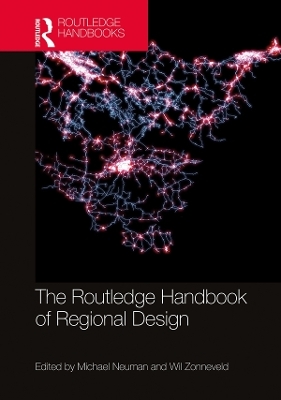
The Routledge Handbook of Regional Design
Routledge (Verlag)
978-0-367-25867-2 (ISBN)
The Routledge Handbook of Regional Design explores contemporary research, policy, and practice that highlight critical aspects of strategy-making, planning, and designing for contemporary regions—including city regions, bioregions, delta regions, and their hybrids.
As accelerating urbanization and globalization combine with other forces such as the demand for increasing returns on investment capital, migration, and innovation, they yield cities that are expanding over ever-larger territories. Moreover, these polycentric city regions themselves are agglomerating with one another to create new territorial mega-regions. The processes that beget these novel regional forms produce numerous and significant effects, positive and negative, that call for new modes of design and management so that the urban places and the lives and well-being of their inhabitants and businesses thrive sustainably into the future.
With international case studies from leading scholars and practitioners, this book is an important resource not just for students, researchers, and practitioners of urban planning, but also policy makers, developers, architects, engineers, and anyone interested in the broader issues of urbanism.
Michael Neuman is Professor of Sustainable Urbanism at the University of Westminster and Principal of the Michael Neuman Consultancy. He is the multi-award-winning author of numerous books, articles, chapters, reports, and plans that have been translated into ten languages. His research and practice span urbanism, planning, design, engineering, sustainability, infrastructure, and governance. He has advised mayors in Europe, the United States, and Australia, the Regional Plan Association of New York, the Barcelona Metropolitan Plan, and other governments and private clients around the world. Wil Zonneveld is Full Professor of Urban and Regional Planning in the Department of Urbanism, Faculty of Architecture and the Built Environment, TU Delft. The subject of his 1991 PhD thesis was the conceptualization of space and territory in Dutch regional and national planning. This subject has been addressed many times since then, extending analyses to include transnational and European levels of scale, with a strong emphasis on visualization and connections with governance capacity.
Part I: Intellectual Underpinnings and Practices
Introduction: The Resurgence of Regional Design
Chapter 1. The Emergence of Regional Design: Recovering a Great Landscape Architecture and Planning Tradition
Chapter 2. European History and Traditions: Revisiting the European Spatial Development Perspective
Chapter 3. The Ecological Underpinnings of Regional Design
Chapter 4. Contemporary Regional Design Theory
Part II: City Region Case Studies
Chapter 5. Urban Policies and Strategies for Balanced Regional Development in Korea
Chapter 6. Japan’s Linear Megalopolis: Shinkansen High-speed Rail as the Spine of a 60-year Mega-region Evolution
Chapter 7. Germany’s 'European Metropolitan Regions'
Chapter 8. Can Megalopolis Continue To Thrive? A Profile of the US Northeast Megaregion and Its Prospects
Chapter 9. The Texas Urban Triangle Megaregion
Chapter 10. Designing the New York Metropolitan Region
Chapter 11. The Santiago de Chile Metropolitan System: Transformative Tensions and Contradictions Shaping Spatial Planning
Chapter 12. Nairobi
Chapter 13. Design and Governance for the Barcelona City Region
Chapter 14. Regional Planning and Regional Design in Greater Paris
Chapter 15. Sydney: Evolution Towards a Tri-city Metropolitan Region and Beyond
Chapter 16. Who Designed Los Angeles? Nature, Profit, Policy, People
Part III: Hydraulic, Ecological, and Bioregional Design Case Studies
Chapter 17. The Dutch Deltametropolis
Chapter 18. The Regional Design of Green Infrastructure in the Pearl River Delta
Chapter 19. Regional Design Stepping into the Sea
Chapter 20. Bioregional Design: The Design Science of the Future
Part IV: Education, Management, and Governance
Chapter 21. Interdisciplinary Pedagogies for Regional Development Challenges: The Re-coupling of Planning, Design and the Social Sciences
Chapter 22. Imagining the Region
Chapter 23. Mapping for Regions
Chapter 24. The Complex Ecology of the City-Region
Chapter 25. The Futures of Regional Design
| Erscheinungsdatum | 25.07.2024 |
|---|---|
| Zusatzinfo | 33 Tables, black and white; 14 Line drawings, black and white; 107 Halftones, black and white; 121 Illustrations, black and white |
| Verlagsort | London |
| Sprache | englisch |
| Maße | 174 x 246 mm |
| Gewicht | 900 g |
| Themenwelt | Naturwissenschaften ► Geowissenschaften ► Geografie / Kartografie |
| Technik ► Architektur | |
| ISBN-10 | 0-367-25867-6 / 0367258676 |
| ISBN-13 | 978-0-367-25867-2 / 9780367258672 |
| Zustand | Neuware |
| Informationen gemäß Produktsicherheitsverordnung (GPSR) | |
| Haben Sie eine Frage zum Produkt? |
aus dem Bereich


